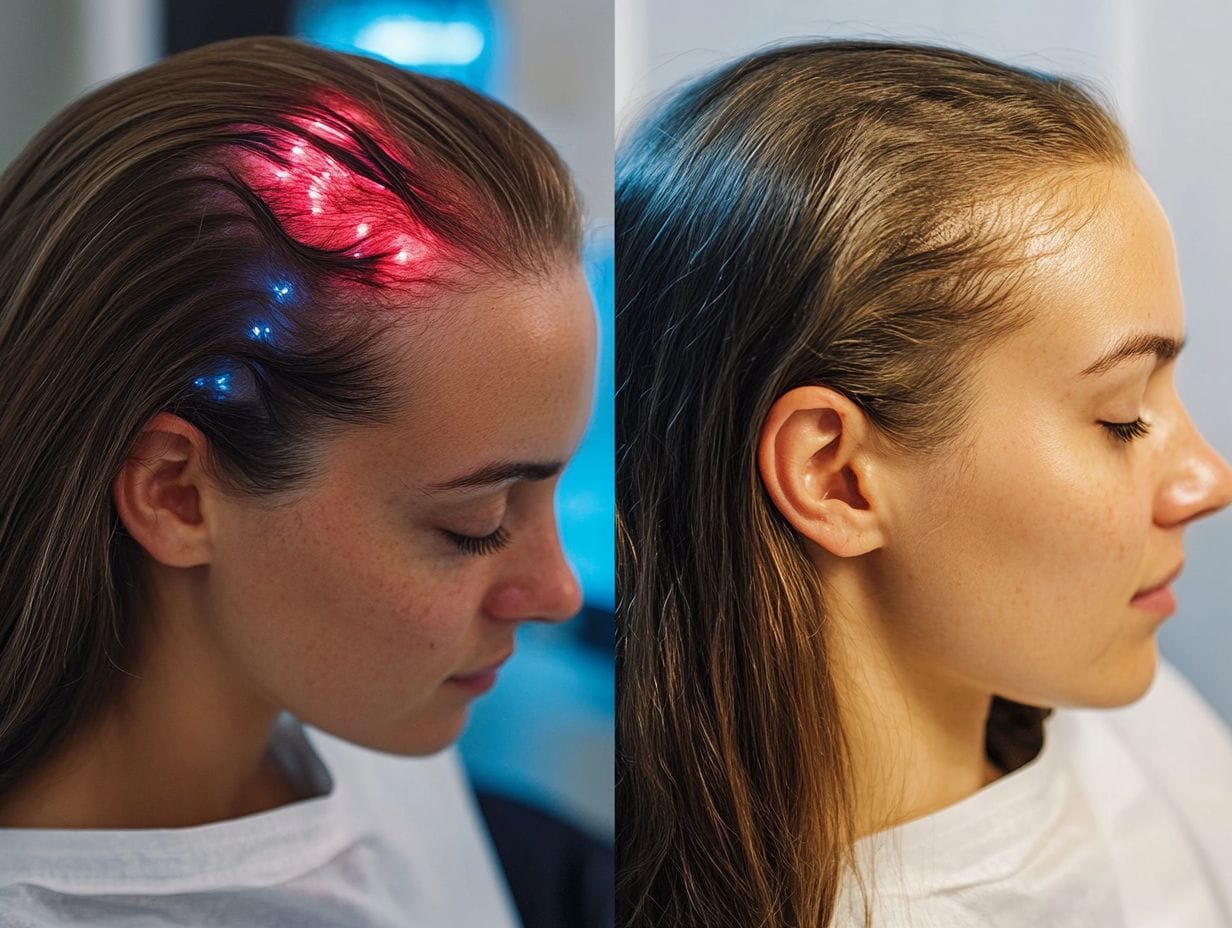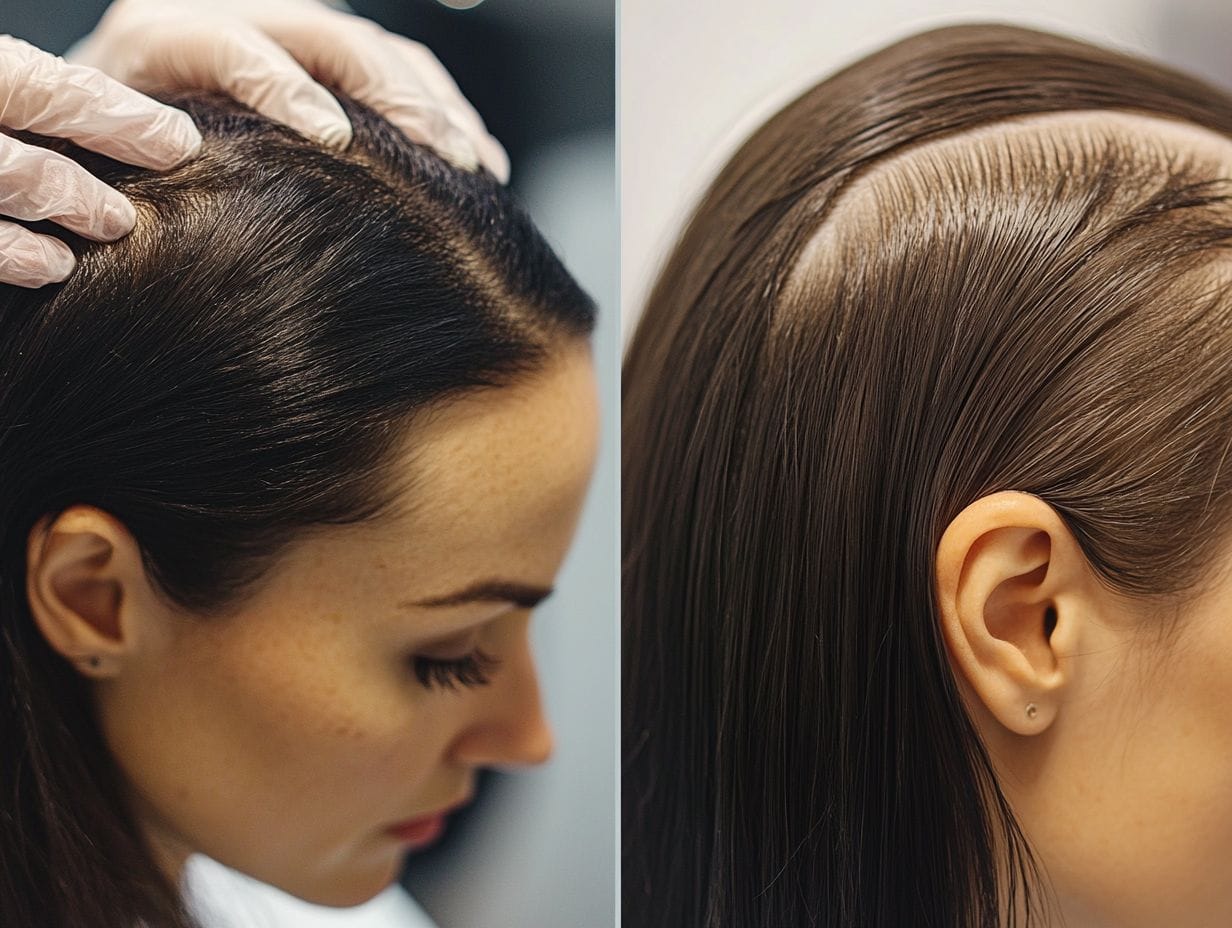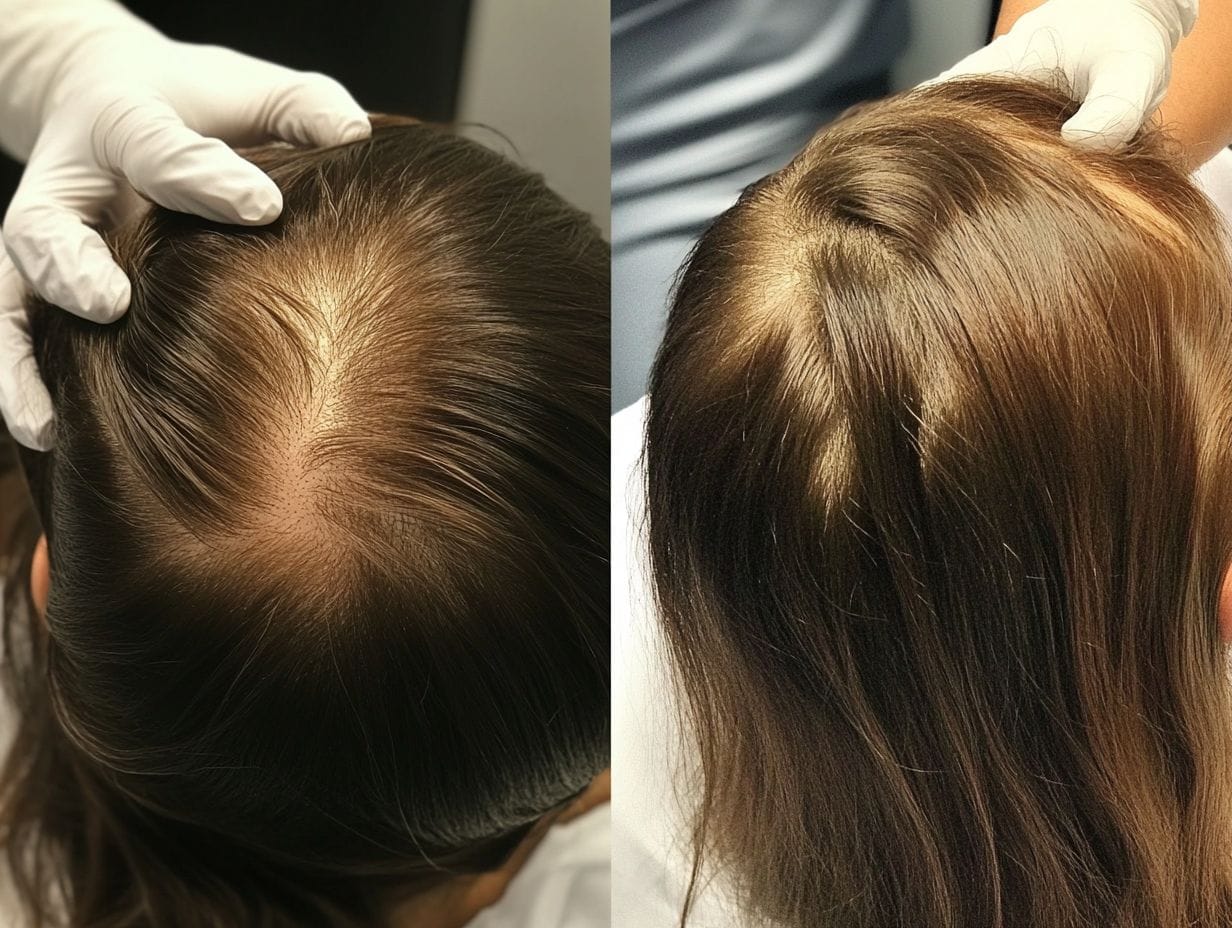Hair thinning can be a distressing experience for many women, often leading to a search for effective solutions.
This article explores the various causes behind hair thinning and examines two popular treatment options: laser therapy and exosome therapy.
It breaks down how each method works, their effectiveness, and compares their costs.
The aim is to guide you in choosing the right treatment for your unique needs, ensuring you make an informed decision on your hair restoration journey.
Understanding Hair Thinning in Women

Understanding hair thinning in women necessitates a comprehensive examination of various factors, including hormonal influences, genetic predispositions, and environmental conditions that contribute to this widespread issue.
As a considerable percentage of women experience hair thinning at some stage in their lives, the demand for effective hair loss solutions has grown significantly. This complex issue impacts not only physical appearance but also psychological well-being, underscoring the importance of exploring viable hair restoration options.
Additionally, it is crucial to comprehend the underlying causes, such as scarring alopecia and telogen effluvium, to effectively address this condition.
Causes and Contributing Factors
The causes and contributing factors of hair thinning in women are multifaceted, encompassing hormonal imbalances, genetic predispositions, lifestyle factors, and nutritional deficiencies. A comprehensive understanding of these elements is essential for identifying effective hair loss solutions tailored to individual needs.
For instance, hormonal fluctuations during critical life stages, such as pregnancy or the menopause, can disrupt the delicate balance of hair growth cycles, often resulting in increased shedding or a reduction in hair density. Additionally, specific genetic traits may predispose certain individuals to more pronounced forms of hair loss, as observed in conditions such as androgenetic alopecia, which often appears to have familial patterns.
Nutritional deficiencies, including insufficient levels of iron, vitamin D, or biotin, can further compromise hair health, underscoring the importance of a balanced diet. Furthermore, lifestyle choices, including effective stress management techniques and appropriate hair care routines, are vital in promoting therapeutic efficacy and enhancing overall scalp health. For those interested in advanced treatments, microneedling for hair loss in women may offer innovative solutions.
Personalised treatment plans that consider these various factors can significantly improve hair regrowth patterns and help restore confidence in affected individuals. For those exploring options, understanding scalp micropigmentation vs. microneedling can provide valuable insights into effective hair loss treatments for women.
Laser Therapy for Hair Thinning
Laser therapy for hair thinning is a non-invasive treatment that employs low-level laser technology to stimulate hair growth and enhance scalp health. This method is widely acknowledged as an effective hair restoration technique, promoting follicle stimulation and improving hair density and thickness without requiring surgical intervention.
Clinical studies have demonstrated that laser therapy can produce positive outcomes for patients, particularly in cases of androgenetic alopecia. As the interest in non-surgical treatments rises, it is crucial for individuals seeking effective hair growth solutions to understand the safety profiles, efficacy, and treatment duration associated with laser therapy. Additionally, comparing options such as hair transplants vs. exosome therapy can provide valuable insights for informed decisions.
How It Works and Effectiveness
Laser therapy employs specific wavelengths of light to penetrate the scalp, effectively targeting hair follicles to promote cellular regeneration and enhance the healing process. This therapeutic approach has gained recognition as an effective solution for hair thinning, with numerous clinical studies demonstrating its efficacy in stimulating hair regrowth.
The innovative application techniques utilised in laser therapy ensure that patients can experience significant improvements in hair density with minimal side effects. It is crucial to consider safety profiles and treatment accessibility when evaluating this non-invasive treatment option. For those exploring various options, comparing exosome therapy vs. topical minoxidil can help determine the best hair loss solution for women.
By utilising specific wavelengths, typically within the range of 650 to 900 nanometres, laser therapy interacts with the underlying biology of hair follicles. This interaction enhances the production of essential growth factors that stimulate hair growth, resulting in rejuvenated follicles and improved scalp health. For more insight on treatment options, including PRP therapy vs. exosome therapy for women’s hair thinning in Coventry, consider exploring the latest advancements.
Numerous patient testimonials indicate satisfaction and observable results, further reinforcing the treatment's credibility. When comparing laser therapy to other hair restoration methods, such as hair transplants or topical treatments, many individuals find the non-invasive nature and minimal downtime of this option to be an appealing alternative for those seeking effective solutions to hair loss. For those considering various options, Minoxidil vs. Exosome Therapy offers valuable insights into which treatment might yield better results for women.
Exosome Therapy for Hair Thinning

Exosome therapy or hair loss represents a significant advancement in regenerative medicine, utilising the capabilities of stem cells and exosomes to promote the health and regeneration of hair follicles. This innovative approach employs extracellular vesicles derived from stem cells, which contain growth factors and proteins critical for hair restoration.
By enhancing the scalp microenvironment, exosome therapy has demonstrated promising results in clinical studies, establishing itself as a formidable alternative to conventional hair loss treatments. For those considering their options, a side-by-side comparison of topical minoxidil and exosome therapy can provide valuable insights. As an increasing number of patients pursue personalised treatment plans, it is essential to comprehend the benefits associated with exosome therapy.
Explanation and Potential Benefits
Exosome therapy or hair loss comprises the application of targeted therapeutic techniques that utilise the regenerative potential of stem cells to facilitate effective hair growth. By delivering high concentrations of growth factors directly to the scalp, this method not only promotes increased hair density but also enhances overall scalp health. The potential benefits of exosome therapy extend beyond hair restoration, yielding improved patient outcomes, as supported by various clinical studies. A comprehensive cost analysis is imperative for patients considering this innovative treatment.
This approach prioritizes treatment accessibility, ensuring that individuals seeking hair restoration options are well-informed and prepared to make decisions that enhance their quality of life. Through proper patient education, prospective recipients can gain an understanding of the mechanisms behind exosome therapy, familiarize themselves with the evidence-based practices that support its efficacy, and appreciate its complexities. The therapy has demonstrated significant improvements in hair texture and thickness, contributing positively to self-esteem and social interactions. For those weighing their options, exploring exosome therapy vs. nutritional supplements can provide valuable insights into effective hair growth solutions.
As more practitioners adopt this advanced technique, ongoing clinical research is expected to reveal additional advantages, thereby enhancing its credibility and expanding its reach within the field of hair restoration. For those interested in effective options, exploring exosome therapy vs. PRP can provide valuable insights into the best treatments for women’s hair regrowth.
Comparison of Laser and Exosome Therapies
The comparison of laser and exosome therapies provides critical insights into their efficacy, safety considerations, and overall patient satisfaction as solutions for hair loss. Both treatments aim to enhance hair growth and scalp health, yet they employ differing mechanisms to achieve these objectives.
Laser therapy utilises non-invasive techniques to stimulate hair follicles, whereasExosome therapy or hair loss centres on regenerative medicine through cellular components derived from stem cells.
It is essential for individuals seeking the most appropriate option for managing hair thinning to understand the nuances of each method, including treatment duration, potential side effects, and associated costs.
Effectiveness, Cost, and Other Factors
When evaluating the effectiveness of laser and exosome therapies, several critical factors come into play, including cost analysis, treatment duration, and patient outcomes. The efficacy of these two methods can vary significantly; laser therapy is often more accessible and cost-effective, while exosome therapy may require a higher initial investment but could potentially yield more significant long-term results.
It is essential to assess the safety profiles of both treatments, such as PRP therapy vs. exosome therapy for female hair loss in Dudley, to facilitate knowledge-based decision making, enabling patients to select the most appropriate option based on their unique conditions and preferences.
A closer examination of patient satisfaction indicates that individuals frequently weigh immediate financial implications against expected benefits. While laser therapy typically offers shorter sessions and lower overall costs, exosome therapy may provide enhanced therapeutic efficacy over time. Clinical evidence supports the notion that, despite its higher upfront cost, exosome therapy can lead to greater patient satisfaction due to its promising outcomes and reduced side effects.
Consequently, a comprehensive assessment of the overall value of each treatment necessitates a nuanced understanding of their cost-effectiveness in conjunction with safety considerations, ultimately guiding patients towards the most suitable therapeutic choice.
Choosing the Right Treatment for You

Selecting the appropriate treatment for hair thinning is a crucial decision that necessitates careful consideration of various factors, including individual circumstances, aesthetic objectives, and the range of available hair loss solutions.
Engaging in a comprehensive consultation process with experienced dermatologists can assist individuals in effectively navigating their options. Tailored treatment plans should integrate the latest advancements in hair restoration, such as laser therapy and exosome therapy, while also taking into account accessibility and cost considerations.
Patient education is essential in give the power toing individuals to make informed decisions that are suited to their specific hair care needs and conditions.
Factors to Consider and Consultation Process
When evaluating hair loss treatments, it is essential to consider several factors to develop a suitable and effective personalised treatment plan.
This initial assessment lays the groundwork for a productive discussion regarding the various potential interventions available. An expert's evaluation not only highlights advancements in treatment innovations but also takes into account safety considerations that are crucial for achieving successful outcomes.
Encouraging open communication during this consultation allows patients to express their concerns and pose questions, thereby fostering a collaborative relationship with their dermatologist. An education-focused approach provides individuals with insights into the latest techniques and their respective efficacy, giving them the power as they explore their options for restoring hair growth. For those considering their choices, checking out the best women’s hair transplant clinics near you might reveal promising solutions.
Frequently Asked Questions
1. What is the difference between laser therapy and exosome therapy for women's hair thinning solutions?
Laser therapy uses light energy to stimulate hair growth, while Exosome therapy or hair loss involves injecting small particles from stem cells to promote hair regeneration.
2. Which therapy is more effective for treating women's hair thinning?

Both laser therapy and exosome therapy have been shown to be effective in treating women's hair thinning. However, the effectiveness may vary depending on individual factors and the severity of hair loss.
3. How long does each therapy take to see results?
Results from laser therapy can usually be seen within 3-6 months, while exosome therapy may take longer, with results typically seen within 6-12 months.
4. Are there any side effects associated with these therapies?
Laser therapy is generally considered to be safe and well-tolerated, with minimal side effects such as temporary redness or itching. Exosome therapy is also considered safe, as the exosomes are taken from the patient's own body, reducing the risk of adverse reactions.
5. How often do I need to undergo these treatments for optimal results?
The frequency of treatments for laser therapy may vary, but it is typically recommended to undergo 2-3 sessions per week for a few months. Exosome therapy usually requires a single treatment, but additional sessions may be recommended for severe cases.
6. Can these therapies be used in combination with other hair loss treatments?
Yes, laser therapy and exosome therapy can be used in combination with other hair loss treatments such as topical medications or hair transplant surgery. However, it is important to consult with a doctor before undergoing any combination treatments.


